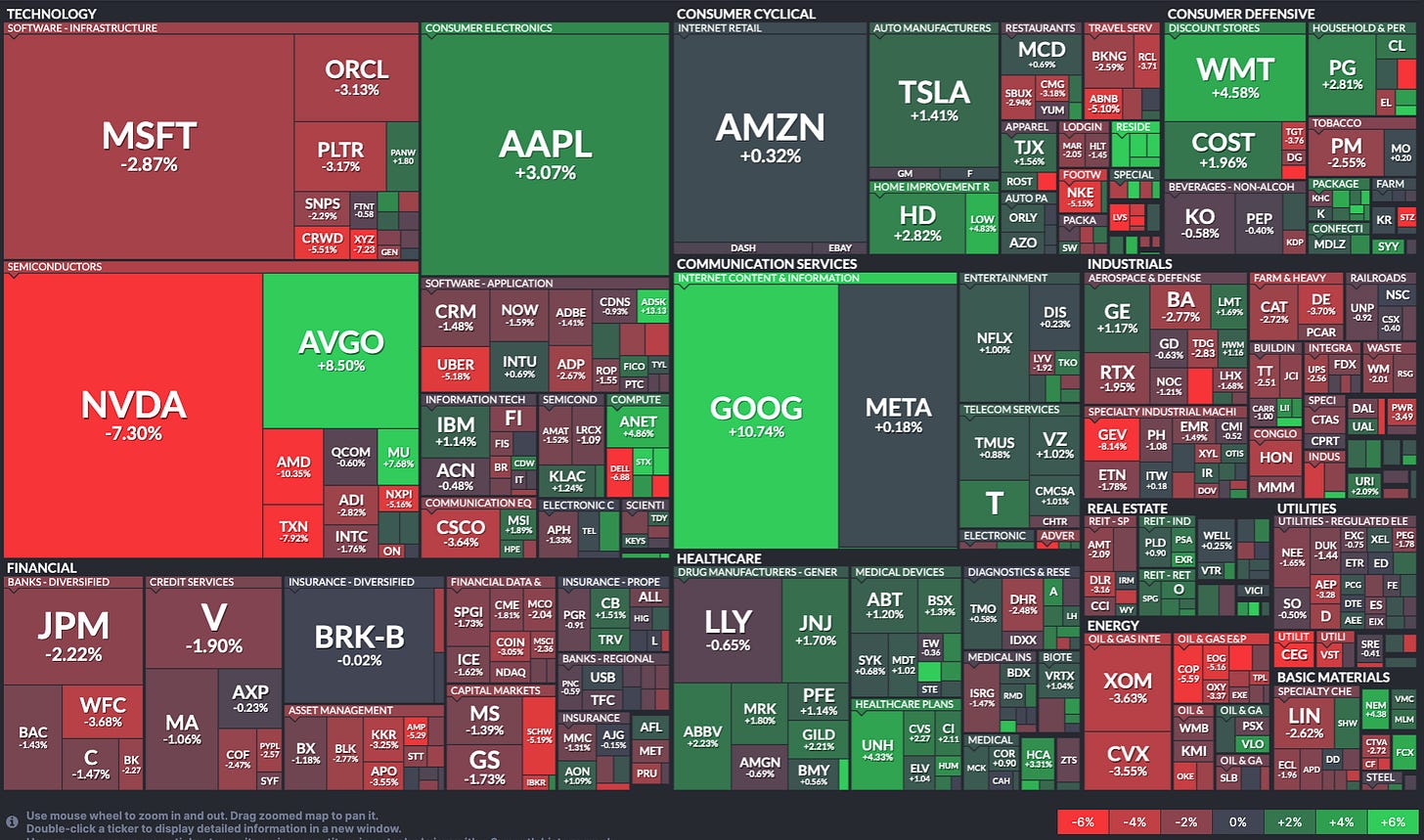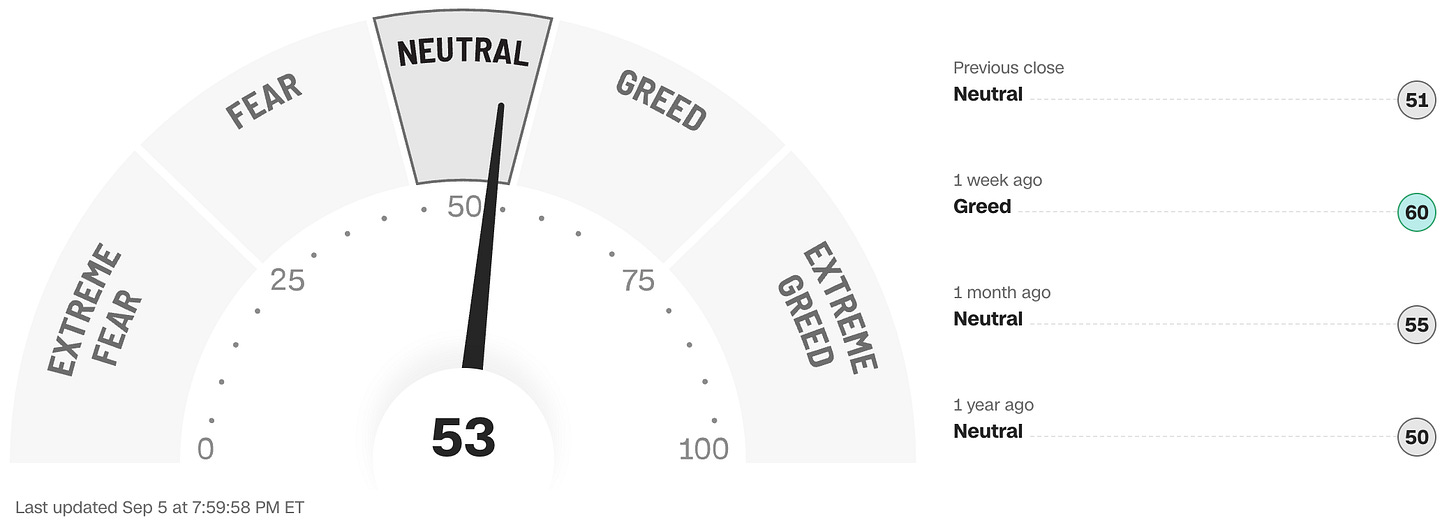Confusion reigned on Wall Street and around the world after the previous Friday’s appellate court decision confirming that IEEPA tariffs are illegal. The exchanges were closed on Monday, but the general sense in the futures market was that, while the smart money was not going to immediately freak out, it was going to have to keep a close eye on how things evolve here.
There was also the small matter of the crucial jobs data release coming up on Friday to think about as well as ongoing concerns about the independence of the Federal Reserve in the light of Trump’s audacious attempt to oust Governor Lisa Cook and replace her with a henchman to do his bidding on the interest-rate setting committee. Wall Street’s historically most tricky month of the year began on Tuesday and this time around it is chock-full of potentially market-moving events (see below).
Traders seemed to be coming to the conclusion that tariffs aren’t vanishing but might possibly be changing. If Trump’s Supreme Court majority does somehow step out of character and actually rule against the president, then financial markets will need to prepare for the upheaval of a likely migration from country-by-country tariffs to the more legally-grounded sector-by-sector ones. That would be very messy for an already dazed and confused US and global business community overseeing trillions upon trillions of dollars of international trade.
Stock indexes took a substantial leg lower, dragged down once again by heavy profit-taking in tech and small cap names. The bond market seemed more focused on the fact that “easy-money” Treasury revenue generated by IEEPA tariffs may dry up and that’s not good for keeping those pesky longer term interest rates under control.
Bond vigilantes around the world began to stir again and the outcome was a serious shift higher in global interest rates with the US 30-year flirting with the 5% level again and multi-decade highs in Europe and Japan.
A highly favorable anti-trust case verdict for Alphabet/Google which allowed the company to keep Chrome and continue to make lucrative product distribution payments to the likes of Apple removed a long-time overhang and nicely boosted both firms’ stock prices on Wednesday. The result was a modest rebound in the indexes, particularly the NASDAQ.
Some lower-key employment data pre-market released on Thursday showed, among other things, that for the first time since before the pandemic, the number of job openings has now fallen below the number of people seeking jobs. The data generally implied continued sluggish economic conditions with US companies not firing but not hiring either and the non-trivial risk of a nasty downside surprise in the payrolls number 24 hours later.
Senate confirmation hearings began for Stephen Miran, Trump’s pick to temporarily replace Adriana Kugler, who quit the Fed interest rate-setting committee in still murky circumstances last month. If confirmed, Miran would unfathomably be allowed to maintain his current job on the White House payroll while sitting on the policy committee of an autonomous entity. When asked, he blah-blahed all the right noises about central bank independence, but he was plainly rewriting history, having recently published that a US president should be able to fire and hire Fed decision-makers “at will”.
Stocks were unfazed and headed north again, comfortably erasing the declines from earlier in the week with the S&P 500 index closing at another new all-time record high and above 6500 for the first time. Interest rates backed off sharply from the elevated levels caused by Tuesday’s spike.
The Jobs Report dropped pre-market on Friday and was alarmingly weak relative to expectations. Only 22k jobs were created in August, there were more downward revisions to prior months’ data and a tick up in the unemployment rate to 4.3%. Any lingering doubts about whether we will get a Fed rate cut on September 17th were swiftly demolished and interest rates plummeted across the board as the prospect of even a jumbo 0.50% cut started getting some votes (see INTEREST RATE EXPECTATIONS below).
The knee-jerk reaction in the stock market was to adopt a “bad news is good news” view that the job numbers will force the Fed to come to rescue with multiple cuts. But things then took a somewhat darker turn as the indexes rolled over on developing fears that the current pace of economic growth stagnation might swamp any of the benefits of lower short term interest rates and they closed lower on the day but a fraction higher for the week.
These next few weeks are going to be crucial to Wall Street. They should give us something of a reading on whether this almost three-year-old rally will continue or if it’s doomed to finally get derailed. In the next month alone, we’ve got a Fed interest rate-setting meeting, more inflation and job reports, ongoing legal proceedings regarding the legality of tariffs and the future of Fed Governor Cook, fiery Senate confirmation hearings, a Triple Witching day and even a possible government shutdown.
And that’s just the stuff that we know about. In this chaotic environment, I think we can safely assume that there’ll be plenty more to capture our attention.
If you are not yet a client of Anglia Advisors and would like to explore becoming one, please feel free to reach out to arrange a complimentary no-obligation discovery call with me.
ARTICLE OF THE WEEK ..
Why are lottery winners far more likely to go bankrupt than the general population?
.. AND I QUOTE ..
“I’m not going to bet against the US market in an environment where earnings are growing, estimates are accelerating, economic data is still generally good and interest rates are going to come down.”
Steve Chiavarone, deputy chief investment officer, Federated Hermes
LAST WEEK BY THE NUMBERS:
Last week’s market color courtesy of finviz.com
Last week’s best performing US sector: Communication Services (two biggest holdings: Alphabet/Google, Meta) ⬆︎ 3.0% for the week
Last week’s worst performing US sector: Energy (two biggest holdings: Exxon-Mobil, Chevron) ⬇︎ 3.4% for the week
SPY, a US Large Cap ETF, tracks the S&P 500 index, made up of 500 stocks from a universe of the largest US companies. Its price rose 0.3% last week, is up 10.4% so far this year and ended the week 0.8% below its all-time record closing high (09/04/2025).
IWM, a US Small Cap ETF, tracks the Russell 2000 index, made up of the bottom two-thirds in terms of company size of a universe of 3,000 of the largest US stocks. Its price rose 1.1% last week, is up 7.6% so far this year and ended the week 2.9% below its all-time record closing high (11/08/2021).
VXUS, a Global Non-US ETF, tracks the MSCI ACWI Ex-US index, made up of over 8,500 of the largest names from a universe of stocks issued by companies from around the world excluding the United States, in both developed and emerging markets. Its price rose 0.6% last week, is up 21.8% so far this year and ended the week 1.0% below its all-time record closing high (08/22/2025).
INTEREST RATES:
FED FUNDS * ⬌ 4.33% (unchanged)
PRIME RATE ** ⬌ 7.50% (unchanged)
3 MONTH TREASURY ⬇︎ 4.07% (4.23% a week ago)
2 YEAR TREASURY ⬇︎ 3.51% (3.59% a week ago)
5 YEAR TREASURY ⬇︎ 3.59% (3.68% a week ago)
10 YEAR TREASURY *** ⬇︎ 4.10% (4.23% a week ago)
20 YEAR TREASURY ⬇︎ 4.72% (4.86% a week ago)
30 YEAR TREASURY ⬇︎ 4.78% (4.92% a week ago)
Data courtesy of the Federal Reserve and the Department of the Treasury as of the market close on Friday
* Decided upon by the Federal Reserve Open Market Committee. Used as a basis for overnight interbank loans and for determining high yield savings interest rates
** Wall Street Journal Prime Rate as of Friday’s close. Used as a basis for determining many consumer loan interest rates such as credit cards, personal loans, home equity loans/lines of credit, securities-based lending and auto loans
*** Used as a basis for determining mortgage interest rates and business loans
AVERAGE 30-YEAR FIXED MORTGAGE RATE:
⬇︎ 6.50%
One week ago: 6.56%, one month ago: 6.65%, one year ago: 6.35%
Data courtesy of Freddie Mac Primary Mortgage Market Survey
INTEREST RATE EXPECTATIONS:
Where will the Fed Funds interest rate be after the next rate-setting meeting on September 17th?
Unchanged from now .. ⬇︎ 0% probability (14% a week ago)
0.25% lower than now .. ⬆︎ 89% probability (86% a week ago)
0.50% lower than now .. ⬆︎ 11% probability (0% a week ago)
With three more rate-setting meetings left in 2025, what is the most commonly-expected number of remaining 0.25% Fed Funds interest rate cuts this year?
⬆︎ Three (up by one from a week ago)
Data courtesy of CME FedWatch Tool
All data based on the Fed Funds interest rate (currently 4.33%). Calculated from Federal Funds futures prices as of the market close on Friday.
PERCENT OF S&P 500 STOCKS ABOVE THEIR 200-DAY MOVING AVERAGE:
⬇︎ 63%
One week ago: 65%, one month ago: 56%, one year ago: 71%
Data courtesy of MacroMicro as of Friday’s market close
This widely-used technical measure of market breadth is considered to be a robust indicator of the overall health of the S&P 500 index. A high percentage (above 70%) generally suggests broad market strength and a bullish trend, while a low percentage (below 30%) may indicate market weakness and a bearish trend.
FEAR & GREED INDEX:
“Be fearful when others are greedy and be greedy when others are fearful.” Warren Buffet.
Data courtesy of CNN Business as of Friday’s market close
The Fear & Greed Index from CNN Business can be used as an attempt to gauge whether or not stocks are fairly priced and to determine the mood of the market. It is a compilation of seven of the most important indicators that measure different aspects of stock market behavior. They are: market momentum, stock price strength, stock price breadth, put and call option ratio, junk bond demand, market volatility and safe haven demand.
Extreme Fear readings can lead to potential opportunities as investors may have driven prices “too low” from a possibly excessive risk-off negative sentiment.
Extreme Greed readings can be associated with possibly too-frothy prices and a sense of “FOMO” with investors chasing rallies in an excessively risk-on environment . This overcrowded positioning leaves the market potentially vulnerable to a sharp downward reversal at some point.
A “sweet spot” is considered to be in the lower-to-mid “Greed” zone.
Note: Anglia Advisors has updated its Privacy Policy. You can view the latest version here.
WWW.ANGLIAADVISORS.COM | SIMON@ANGLIAADVISORS.COM | CALL OR TEXT: (646) 286 0290 | FOLLOW ANGLIA ADVISORS ON INSTAGRAM
This material represents a highly opinionated, speculative assessment of the financial market environment based on assumptions and prevailing information and data at a specific point in time and is always subject to change at any time. Although the content is believed to be correct at the time of publication, no warranty of its accuracy or completeness is ever given. It is never to be interpreted as an attempt to forecast any future events, nor does it offer any kind of guarantee whatsoever of future results, circumstances or outcomes.
The material contained herein is not necessarily complete and is also wholly insufficient to be relied upon as research or investment advice or as a sole basis for any financial determinations, including investment decisions or making any kind of consumer choices, without further consultation with Anglia Advisors or other fully-qualified Registered Investment Advisor. The user assumes the entire risk of any decisions made or actions taken based in whole or in part on any of the information provided in this or any other Anglia Advisors published content.
Under no circumstances is any Anglia Advisors’ content ever intended to constitute tax, legal or medical advice and should never be taken as such. Neither the information contained nor any opinion expressed herein constitutes a solicitation for the purchase of any security or asset class. No formal client advice may be rendered by Anglia Advisors unless and until a properly-executed client engagement agreement is in place.
Posts may contain links or references to third party websites or may post data or graphics from them for the convenience and interest of readers. While Anglia Advisors might have reason to believe in the quality of the content provided on these sites, the firm has no control over, and is not in any way responsible for, the accuracy of such content nor for the security or privacy protocols that external sites may or may not employ. By making use of such links, the user assumes, in its entirety, any kind of risk associated with accessing them or making use of any information provided therein.
Those associated with Anglia Advisors, including clients with managed or advised investments, may maintain positions in securities and/or asset classes mentioned in this post.
If you enjoyed this post, why not share it with someone?













